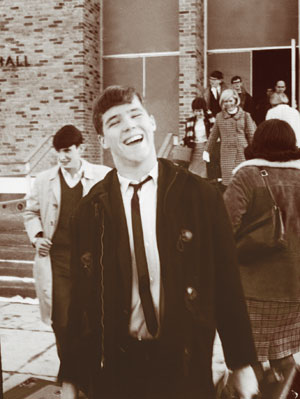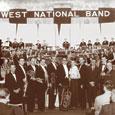Education critics decry the absence of accountability in schools, complaining that no one is held accountable, the standards of quality go unmonitored, and no one seems to care about following through. However, accountability, personal responsibility, and achievement are the hallmarks of excellent music programs. The key to developing such programs is generating student enthusiasm for and commitment to the ensemble. Here are some ways I generated student commitment.
.jpg) Modeling
Modeling
Students don’t always believe what they hear, but they do believe what they see. This point was brought home to me early in my career. A new student came into my office and said, “Mr. Battisti, I want you to know I don’t like music.” His comment startled me. When I asked why he had elected to play in the band, he replied, “You’re different from the rest of them. I’m watching you.” From that moment on I realized I had to be aware of what I did and how I did it because students were watching me. After watching me for three years, this student went into music.
I demanded that students practice their band music 30 minutes a day and come to rehearsals prepared. To model what I wanted them to do, I studied scores in my office and made sure the desk I studied at was located where students could see me. I also placed a sign on the door that read “Do Not Disturb – Studying and Preparing for Tomorrow’s Rehearsal.” A picture is worth a thousand words, and so is a teacher who models what he wants his students to do.
Everybody Is Important
Conveying to students how important they are as individuals in the band’s quest for excellence is extremely important. Whenever a student was in school but absent from a rehearsal, I would try to find that student and speak with him one on one. I think most students feared they were going to get a lecture about their lack of responsibility. However I always said, “We missed you at today’s rehearsal. It wasn’t as good as it could have been because you weren’t there to make your contribution.” I think my message made the point that each student’s contribution was important.
Establishing Good Habits
When I started teaching I wanted the brass students to incorporate long tones, lip slurs, scales, and articulation exercises into their daily practice. To reinforce my demand I asked each student to stop by my office when they arrived at school each morning and mark down the amount of time they practiced each of these. I tracked down students who forgot to remind them that this was required, and students soon understood how important this responsibility was. The point was not to keep a tally of who forgot to practice but to help students incorporate good habits into their daily practice routine. I believe helping students develop good habits is one of the primary tasks of teachers.
Recognizing Good Playing
I wanted my students to recognize and appreciate classmates who played well in rehearsals. Professional players respond to good playing by shuffling their feet. I got my students to respond in a similar manner whenever a classmate played well. This supportive and appreciative gesture generated much good feeling and happiness.
Non-Verbal Communication
Responding to non-verbal instruction is something that students encounter only when playing in a musical ensemble; the instructions in other classes are almost exclusively verbal. I realized that if I wanted to establish this new form of communication I would have to be patient in rehearsals and resist the temptation to explain what I wanted when my gestures failed to elicit the response I hoped for.
It took time for the students to adapt to this new form of communication, but developing the ability to speak to each other non-verbally made for some magical performances. Every year I programmed one technically simple piece, such as Grainger’s Irish Tune from County Derry, for which I memorized the score and students memorized their parts. These performances were always exciting; students watched, listened, communicated, and responded exceptionally well.
Musical Experiences
I wanted my students to experience music in three ways: performing, consuming, and creating. Perfor-mance happens all the time in band and chamber groups, but I also wanted students to appreciate and enjoy attending concerts and recitals. I invited the best bands and chamber groups to visit Ithaca and perform for the students and the public. Among the ensembles that performed at Ithaca High School were groups from Eastman, Oberlin, the University of Michigan, Luther College, and Ithaca College as well as the United States Air Force Band and New York Brass Quintet. Directors in rural areas may consider teaming up with neighboring schools to bring a guest artist to the area for a few days, with one day scheduled for each town.
I also took band members on 100-mile bus trips to concerts at Eastman and encouraged them to attend performances at Cornell and Ithaca College. Calendars for all Ithaca-area concerts were distributed to students. When they graduated I wanted them to remain lovers of music – if not as performers, then as listeners.
To get students to create music they had to become composers. I asked every student to write a solo piece for their instrument. The first pieces they wrote were generally imitations of music they were already playing. However, little by little they became more inventive and imaginative. These experiences broadened their insights and knowledge about how composers constructed music. This proved to be invaluable because it helped them better understand the music they studied in band and chamber groups.
Togetherness
There were many things that attracted band members to the Ithaca High School music building. Foremost were the band’s musical activities, but students also came before and after school and during lunch breaks to read the band bulletin board and look at hundreds of photographs of the band and themselves that lined the corridors of the music building. The pictures were a huge attraction. The band bulletin board, located outside my office, contained a broad range of notices: rehearsal plans for the next three days, important announcements about band activities, community musical events, articles, information about visiting guest artists, letters addressed to the band, and scholastic and athletic achievements of band members.
Fundraising activities were also group oriented. We kept individual fundraising to a minimum, but painted houses as a group over a weekend and organized huge chicken barbecues each year. Doing things together was one of the things that defined the Ithaca High School Band.
I believed that the students I taught at Ithaca High School were extremely special. Therefore I thought I had to create the best program possible – one that was so exciting and interesting that it would stimulate and motivate everyone to become the best they could be. Membership in the Ithaca High School Band took great commitment, dedication, and hard work from everyone. Students became aware that seeking excellence required extraordinary dedication and effort, and we all strived to be the best we could be.






